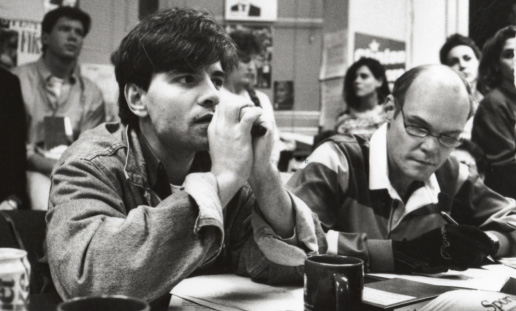The War Room
I've long harbored suspicion toward documentary films, which purport to show "the real thing." The term cinema verite describes an attempt to utilize real dialogue and actual scenarios without embellishment. 1993's THE WAR ROOM, directed by the husband and wife team of Chris Hegedus and D.A. Pennebaker has been described that way. It certainly feels it. Doc viewers can never know for sure if one of the subjects was encouraged to say something "interesting" or if a vivid scene was merely contrived. Or if events in a timeline are swapped around or untruthfully reported. There is always a certain dishonesty in any film, as what you're seeing has been altered, remixed, green screened, what have you. Even in documentaries. Like when the camera cuts to an appreciative audience but you're never quite sure if what they're reacting to is what was just shown on stage.
THE WAR ROOM, which goes behind the scenes of Arkansas governor Bill Clinton's 1992 Presidential campaign, feels plenty authentic. This is mainly because its subjects are so colorful that no trickery was needed. The future President is seen occasionally, rarely with his guard down. But campaign manager James Carville, an outspoken political consultant from Louisiana known as the "ragin' Cajun", and campaign media director/fellow spin doctor George Stephanopolous just about sear the screen with their enthusiasm and confidence that Bill Clinton will be the 42nd POTUS.
Fellow campaign manager David Wilhelm, who would later chair the DNC, declined to be included in this film.
Most of THE WAR ROOM takes place following the New Hampshire primary. The film crew was more or less embedded at Clinton Campaign Headquarters in Little Rock and indeed much of the action is in the titular room, where Carville leads meetings and argues over font size. He's a brash, wickedly smart opportunist who favors very casual clothing and seems to absorb the media intravenously. He's ready to jump on a leaked story alleging that George Bush Sr.'s re-election campaign materials were printed in Rio de Janeiro, not the good ol' U.S. of A. There's also some controversy about campaign posters. He's involved in just about every detail, and his endearing drawl makes even the most mundane of things sound fascinating. Carville, who went on to have a career as a political commentator on cable news outlets (and occasional actor), is an entirely compelling character who gives many fictional counterparts a run for their money. We additionally get a few scenes with his future bride, Republican strategist Mary Matalin.
Stephanopolous, a former Rhoades scholar, is seen trying to defend Clinton's character during the Gennifer Flowers scandal. And coach his team on how to comment on the Presidential debates by focusing on one idea, repeated over and over to the media. A sound bite, something George would perpetuate in his own later career as a network TV pundit and talk host. He is a yin to Carville's yang - calm, well dressed, methodical. He has a memorable phone call with a member of the press late in the film that really cuts to the marrow, and feels genuine.
The directors always make their documentary look and feel cinematic, whether it's Carville rallying the troops while clad in his mesmerizingly colorful jersey, or Stephanopolous talking on the phone to Clinton on election night while a stop light flashes behind him. The fly on the wall style works beautifully, and we get such a lived in feeling for the headquarters that we feel we are also there, ready to commit to damage control or whatever unpredictability is next. THE WAR ROOM is fine filmmaking and great history. This is essential viewing.



Comments